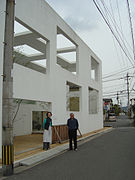Sou Fujimoto (藤本 壮介, Fujimoto Sōsuke, born 1971) is a Japanese architect.
Sou Fujimoto | |
|---|---|
藤本 壮介 | |
 (2009) | |
| Born | 1971 (age 52–53) Hokkaido, Japan |
| Nationality | Japanese |
| Alma mater | University of TokyoÉcole Spéciale d'Architecture |
| Occupation | Architect |
| Organization | Sou Fujimoto Architects |
| Website | www |
Born in Hokkaido in 1971,[1] he graduated from the University of Tokyo in 1994, and established his own office, Sou Fujimoto Architects, in 2000.[2] Noted for delicate light structures and permeable enclosures, Fujimoto designed several houses, and in 2013, was selected to design the temporary Serpentine Gallery pavilion in London.[3] In 2021, Fujimoto received the master's degree from l’École Spéciale d’Architecture in Paris.[4]
Fujimoto published a book in 2008 called Sou Fujimoto: Primitive Future.[5] It contains an overview of his projects up to that date, and it explains his concept of primitive future and how he uses it in his work.[5][6]
Career
After establishing Sou Fujimoto Architects in 2000, Fujimoto went on to design buildings across Japan and Europe.[7] Many of his designs are built around his idea that the function of a building is decided by human behavior.[8] In 2019, Fujimoto was selected as one of 23 architects to "reinvent" Paris.[9] His contributions to this project include a redesign of a plot in the 17th arrondissement of Paris.[9]
Selected works
- Final Wooden House, Kumamoto, 2005–08
- Children's Centre for Psychiatric Rehabilitation, Hokkaido, Japan, 2006[10]
- T House, Gunma, Japan, 2006-2010[10]
- N House, Oita, 2008[11]
- House before House, Utsunomiya, 2009[12]
- Tokyo Apartment, Tabashi-ku, Tokyo, 2006-10[13]
- Musashino Art University Museum and Library, Tokyo, Japan, 2010[14]
- Toilet in Nature, Chiba, Japan, 2012[10]
- House K, Nishinomiya, Hyogo, Japan, 2011-2013[15]
- Serpentine Gallery Pavilion, London, 2013[16]
- Bus Stop in Krumbach, Austria, 2014[17]
- Naoshima Pavilion, Naoshima, Kagawa, Japan, 2016 [18]
- L'Arbre Blanc, Montpellier, France, 2017 (est.)[19][20]
- House of Hungarian Music, Budapest, Hungary, 2022[10][21]
- Mille Arbres (A Thousand Trees), Paris, France, 2016-2023 (est.)[10]
- Final Wooden House
- N House
- House before House, Utsunomiya
- Serpentine Gallery Pavilion, London
- House of Hungarian Music, Budapest
Awards
- JIA New Face Award, 2004[6]
- International Design Competition for the Environment Art Forum, 1st Prize, 2004[6]
- Wooden House Competition, Kumamoto, 1st Prize, 2005[6]
- Architectural Review Award Grand Prize, 2006[22]
- Kenneth F. Brown Architecture Design Award, 2007[6]
- Japanese Institute of Architecture Grand Prize, 2008[6]
- Wallpaper Design Award, 2009[22]
- Taiwan Tower International Competition: First Prize, 2011 [23]
- Marcus Prize for Architecture, 2013[22]
- Kyoto Global Design Awards Best100, 2023[24]




